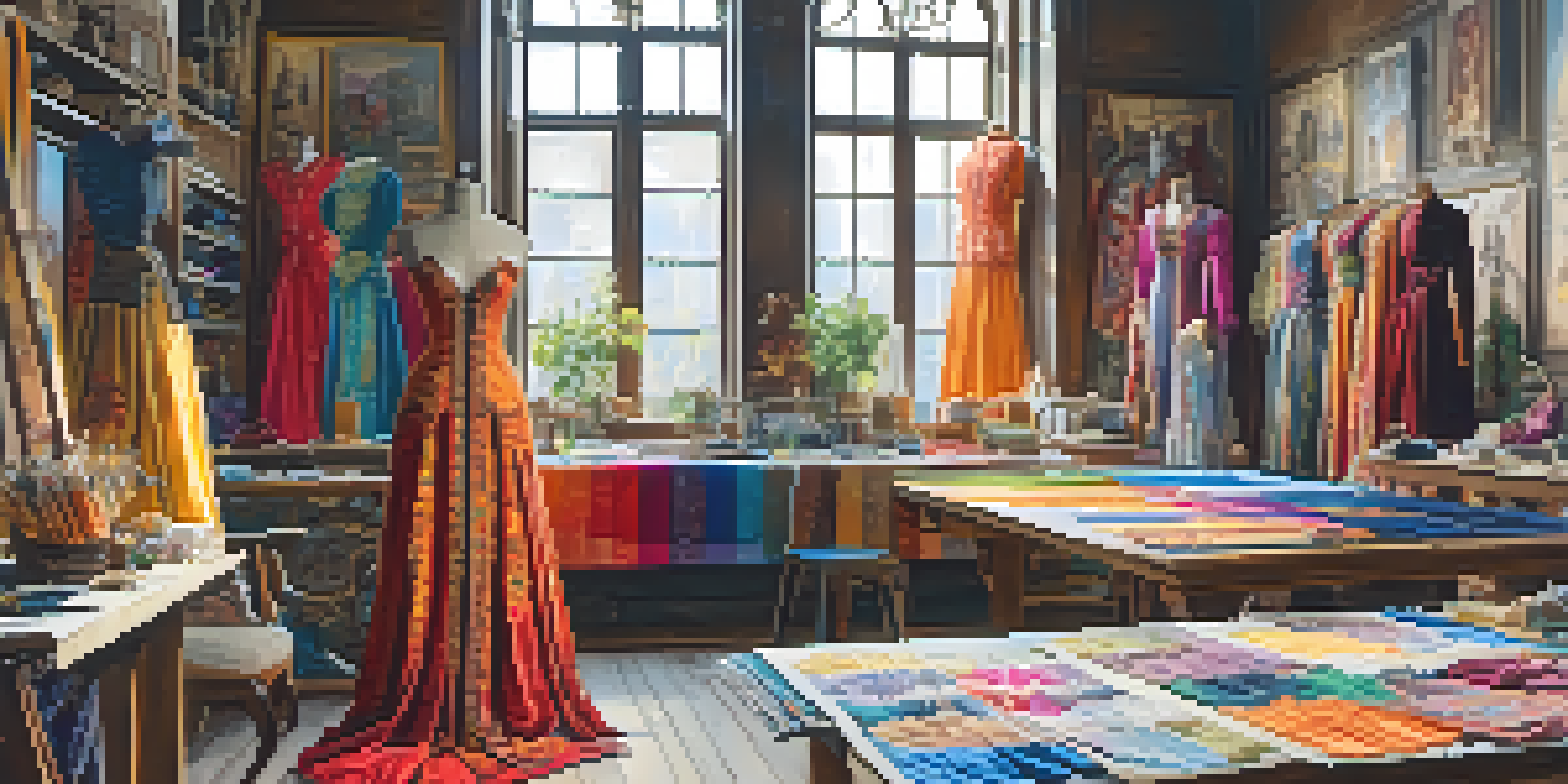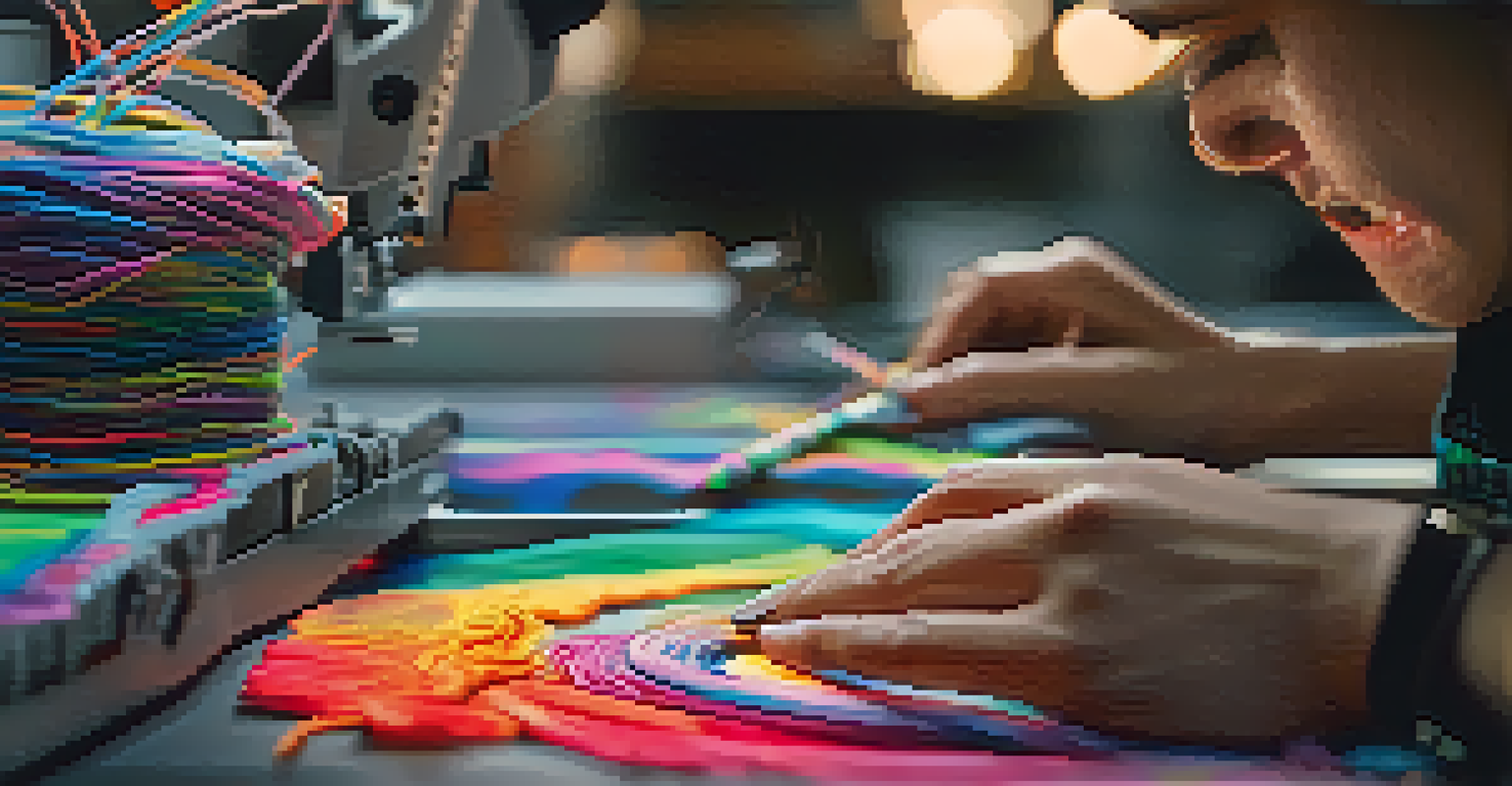The Connection Between Costume Design and Global Fashion

Understanding Costume Design in the Fashion World
Costume design plays a crucial role in shaping the visual narrative of film, theater, and television. It involves creating outfits that not only reflect a character's personality but also resonate with the audience. Just like fashion, costume design draws inspiration from cultural trends, historical contexts, and artistic movements, making it a significant player in the global fashion arena.
Fashion is the armor to survive the reality of everyday life.
For example, the flamboyant costumes in 'Moulin Rouge!' not only served the characters but also showcased early 2000s fashion trends, merging theatricality with reality. This blending of cultures and styles creates a unique dialogue between costume design and global fashion, where both fields influence one another. Essentially, costume design acts as a mirror reflecting contemporary fashion while pushing creative boundaries.
Moreover, the relationship between costume design and fashion is reciprocal; designers often look to costumes for inspiration, leading to runway pieces that echo the vibrant world of film and theater. As trends evolve, the lines blur between what is considered high fashion and what is merely theatrical, creating a fascinating interplay that continues to evolve.
Cultural Influences on Costume Design and Fashion
Costume design is deeply rooted in cultural narratives, drawing from diverse traditions, symbols, and aesthetics. Designers often incorporate elements from various cultures, resulting in costumes that tell rich stories and evoke emotions. This cultural tapestry not only enhances the authenticity of a production but also introduces audiences to unfamiliar fashion influences from around the world.

For instance, films like 'Black Panther' brought African-inspired designs to the forefront, highlighting the beauty and diversity of African heritage while influencing global fashion trends. As these elements enter mainstream fashion, they encourage conversations about representation and appreciation of different cultures. It's a reminder that fashion is not just about aesthetics but also about respect and understanding.
Costume Design Influences Fashion
Costume design not only reflects a character's personality but also shapes and informs global fashion trends, creating a dynamic interplay between the two fields.
In today's globalized world, the cross-pollination of ideas is more prevalent than ever. Costume designers and fashion creators are increasingly collaborating, leading to innovative designs that celebrate cultural diversity while also challenging stereotypes. This collaboration enriches both fields, fostering a sense of unity and creativity that resonates with audiences worldwide.
The Role of Technology in Costume Design and Fashion
Technology has revolutionized both costume design and global fashion, enabling creators to push their artistic boundaries. From 3D printing to digital fabric printing, modern tools allow for intricate designs that were previously unimaginable. This technological advancement not only enhances the visual appeal of costumes but also streamlines the design process, making it more efficient.
Costume design is a silent storyteller, conveying character and intent without uttering a word.
For example, the use of virtual reality in costume visualization allows designers to see how their creations will move and interact on screen. This innovation can lead to better-fitting designs and more cohesive looks that resonate with audiences. Additionally, fashion designers are increasingly adopting similar technologies, creating collections that are both avant-garde and accessible, blurring the lines between costume and couture.
Moreover, social media plays a pivotal role in how costume design influences global fashion trends. Platforms like Instagram and TikTok provide a space for designers to showcase their work, allowing audiences to engage with their designs in real-time. This immediate feedback loop fuels creativity and encourages experimentation, leading to a vibrant exchange of ideas across the fashion landscape.
Iconic Films and Their Impact on Fashion Trends
Certain films have become iconic not just for their storytelling but also for their unforgettable costumes that set fashion trends. Movies like 'Breakfast at Tiffany's' and 'The Devil Wears Prada' have influenced generations, showcasing styles that remain relevant in fashion today. These films serve as cultural touchstones, reminding us of the power of visual storytelling and its impact on personal style.
For instance, Audrey Hepburn's little black dress in 'Breakfast at Tiffany's' has transcended its cinematic context to become a timeless fashion staple. Similarly, the chic wardrobe of Miranda Priestly in 'The Devil Wears Prada' has inspired countless fashion enthusiasts to embrace bold styles. These examples highlight how costume design can shape and redefine fashion norms, creating lasting impressions.
Cultural Narratives Enhance Authenticity
Incorporating diverse cultural elements in costume design enriches storytelling while promoting representation and appreciation in mainstream fashion.
As we look back, it becomes clear that the marriage of film and fashion is a powerful force, often driving trends that ripple through the industry. Designers frequently reference iconic costumes in their collections, ensuring that the influence of cinematic fashion remains strong. This relationship emphasizes the importance of storytelling in fashion, where every piece can evoke emotions and memories.
Costume Design Education and Its Influence on Fashion
The education of costume designers plays a pivotal role in shaping the future of fashion. Institutions that offer programs in costume design often emphasize the historical and cultural contexts of fashion, equipping students with a deeper understanding of trends. This education creates a bridge between historical knowledge and contemporary practice, fostering innovation that respects tradition.
Students learn how to blend materials, techniques, and styles, which can lead to groundbreaking designs that influence both the film and fashion industries. For example, a designer trained in historical costume may create modern pieces that pay homage to the past while appealing to current tastes. This synthesis of old and new is what keeps fashion vibrant and continuously evolving.
Furthermore, as costume designers enter the fashion world, they bring unique perspectives that challenge conventional design principles. Their experiences in storytelling and character development enrich the fashion landscape, encouraging the creation of collections that resonate on a deeper level with consumers. This cross-pollination underscores the importance of education in shaping not only individual careers but also the broader fashion narrative.
Sustainability in Costume Design and Fashion
Sustainability is becoming increasingly important in both costume design and global fashion, as creators recognize the environmental impact of their choices. Costume designers are exploring eco-friendly materials and practices, often repurposing fabrics to create stunning looks that minimize waste. This commitment to sustainability resonates with audiences who are becoming more conscientious consumers.
For example, some designers are turning to vintage fabrics and thrifted pieces, giving new life to forgotten garments while reducing the demand for new materials. This trend not only results in unique costumes but also encourages a culture of recycling and upcycling in fashion. The emphasis on sustainability is more than just a trend; it's a movement toward responsible design that respects our planet.
Sustainability Drives Design Choices
The growing emphasis on sustainability in both costume design and fashion encourages the use of eco-friendly materials and practices, fostering responsible creativity.
In this context, collaborations between costume designers and fashion brands are becoming more common. By combining forces, they can create collections that emphasize sustainability while maintaining high aesthetic standards. This partnership exemplifies how the worlds of costume design and fashion can work together to promote a more sustainable future.
The Future of Costume Design and Its Fashion Connection
As we look to the future, the relationship between costume design and global fashion is poised for exciting developments. With the rise of digital fashion and virtual experiences, costume designers have more tools than ever to explore their creativity. This evolution opens up new possibilities for how stories are told and experienced through fashion.
Additionally, the increasing emphasis on inclusivity and diversity in both industries signals a shift toward representation that reflects a wider range of experiences. Designers are recognizing the importance of telling diverse stories through costume, which directly influences fashion trends and consumer preferences. This focus on inclusivity enriches both fields, ensuring that a variety of voices are heard.

Ultimately, the future of costume design and its connection to global fashion lies in collaboration, innovation, and a shared commitment to storytelling. As these industries continue to evolve, we can expect to see even more dynamic exchanges that blur the lines between screen and runway, further solidifying the importance of costume design in the fashion narrative.